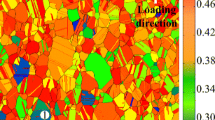Abstract
Specificities of the theory of deformation interactions in polycrystalline alloys are discussed in this work. It is shown that, in the continuous approximation, these interactions are completely determined by the dilatation components of elastic and inelastic strain fields created by the systems of grain boundaries and the system of impurity atoms. Formulas and estimates for various types of deformation interactions are presented. Problems concerning the effect of the boundaries on the lattice parameters, the concentration expansion of the lattices of inhomogeneous alloys, and the interaction of grain boundaries are discussed.

Similar content being viewed by others
REFERENCES
A. G. Khachaturyan, Theory of Phase Transformations and Structure of Solid Solutions (Nauka, Moscow, 1974) [in Russian].
M. A. Krivoglaz, Theory of Scattering of X-rays and Thermal Neutrons in Real Crystals (Nauka, Moscow, 1967) [in Russian].
A. A. Smirnov, Theory of Interstitial Alloys (Nauka, Moscow, 1979).
D. Eshelbi, Continual Theory of Dislocations (Inostrannaya Literatura, Moscow, 1963) [in Russian].
M. A. Shtremel’, Strength of Alloys. Chap. 2. Deformation (MISiS, Moscow, 1997) [in Russian].
J. P. Hirth and J. Lothe Theory of Dislocations (Cambridge University Press, Cambridge, 2017).
L. S. Vasil’ev and S. L. Lomaev, “Excess volume in materials with dislocations,” Phys. Met. Metallogr. 120, No. 7, 709–715 (2019).
L. S. Vasil’ev and S. L. Lomaev, “Influence of pressure on the processes of formation and evolution of the nanostructure in plastically deformed metals and alloys,” Phys. Met. Metallogr. 120, No. 6, 600–606 (2019).
L. E. Karkina, I. N. Karkin, A. R. Kuznetsov, I. K. Razumov, P. A. Korzhavyi, and Yu. N. Gornostyrev, “Solute–grain boundary interaction and segregation formation in Al: First principles calculations and molecular dynamics modeling,” Comput. Mater. Sci. 112, 18–26 (2016).
V. G. Pushin, V. V. Kondrat’ev, and V. N. Khachin, Pretransitional Phenomena and Martensitic Transformations (Ural Branch RAS, Yekaterinburg, 2020) [in Russian].
Yu. L. Klimontovich, Statistical Physics (Nauka, Moscow, 1982).
L. I. Sedov, Continuum Mechanics (Nauka, Moscow, 1970), Vol. 1 [in Russian].
L. S. Vasil’ev and S. L. Lomaev, “Excess volume formation in single-component nanocrystalline materials,” Fiz. Mezomekh. 20, No. 2, 50–60 (2017).
K. Lu and Y. H. Zhao, “Experimental evidences of lattice distortion in Nanocrystalline Materials: 1–4,” Nanostruct. Mater. 12, No. 1–4, 559–562 (1999).
J. Sheng, G. Rane, U. Welzel, and E. J. Mittemeijer, “The lattice parameter of nanocrystalline Ni as function of crystallite size,” Phys. E 43, No. 6, 1155–1161 (2011).
Funding
This work was carried out within research projects nos. АААА-А17-117022250038-7 and АААА-А18-118020190104-3.
Author information
Authors and Affiliations
Corresponding author
Additional information
Translated by E. Chernokozhin
APPENDIX
APPENDIX
EXCESS VOLUME OF BOUNDARIES
Let us consider the excess volume density distribution \({{\varepsilon }_{{0V}}}({\mathbf{r}})\) for a single unrelaxed plane special boundary with the tilt {n10}, \(\left| n \right| \geqslant 2\) (Fig. 1а) [13]. The boundary connects crystallites K1 and K2 along the planes A1 and A2. In Fig. 1b, the shaded square abcd shows the volume occupied by an atom in an ideal lattice. Therefore, the broken line \({{y}_{1}}(x)\) is the upper boundary of crystallite K1 and the line \({{y}_{2}}(x)\) is the lower boundary of crystallite K2 (Fig. 1c). Hence, the distribution of excess volume per 1 m2 of the boundary is determined by the difference
From definition (16), we find
Here, H is the width of the zone of irreversible volume changes. The form of functions \({{y}_{1}}(x)\) and \({{y}_{2}}(x)\) on the length of the period l for boundaries with an inclination angle θ and a relative displacement of crystallites by an arbitrary vector \({\mathbf{d}} = \{ {{x}_{0}},{{y}_{0}}\} \) (y0 is the distance between planes A1 and A2, Fig. 1a) is determined by the formulas (see Figs. 1b and 1c):
Here, \({{\varepsilon }_{0}} = h\) is the mean excess volume per 1 m2 of the unrelaxed boundary (see Fig. 1c) [13].
Rights and permissions
About this article
Cite this article
Vasil’ev, L.S., Lomaev, I.L. & Lomaev, S.L. Deformation Interactions in Polycrystalline Alloys. Phys. Metals Metallogr. 121, 1097–1104 (2020). https://doi.org/10.1134/S0031918X20110095
Received:
Revised:
Accepted:
Published:
Issue Date:
DOI: https://doi.org/10.1134/S0031918X20110095



